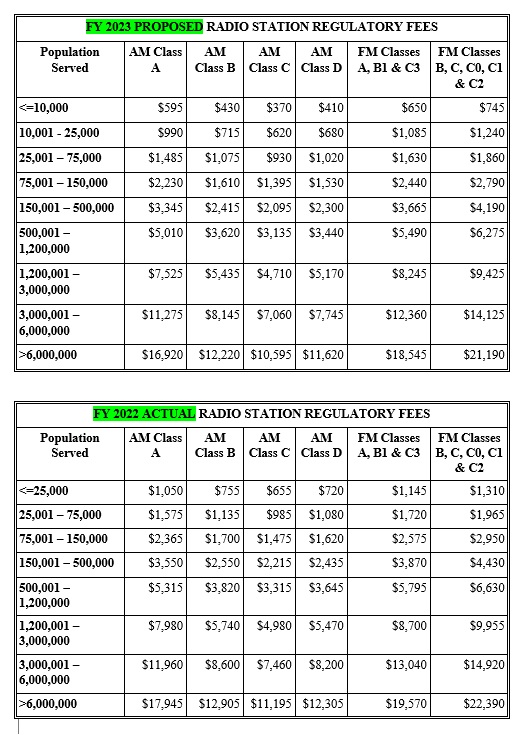U.S. radio stations will pay a bit less in regulatory fees this year under a plan just released by the FCC. Radio stations in the smallest markets would get more substantial relief.
While the fee schedule has not officially been adopted yet, it seems a safe bet given the context.
Broadcast groups including the National Association of Broadcasters have been critical of how the commission apportions fees to various industries that it regulates. Now, in releasing planned fees for fiscal 2023, the commission says it performed “a high-level, yet comprehensive, staff analysis of the work being performed by commission employees.” (For fiscal 2022, radio station fees were finalized only September and went up 7 to 8%, though less than originally proposed.)
While the notice of proposed rulemaking for FY2023 does not incorporate many of the specific changes that were suggested by the NAB and others, the FCC does propose to reallocate some indirect FTEs, or full-time employee positions, as direct FTEs when it calculates fees.
“After our review of the work within the commission’s bureaus and offices, we recognize that experts in the non-core bureaus and offices engage in measurable work associated with the oversight and regulation of regulatory fee payors,” it wrote.
For radio, the upshot is a proposed schedule of fees for this fiscal year that are lower than last year’s. See the two charts at bottom of this story. For instance a Class B FM serving a population of a million people would pay $6,275, down from $6,630 last year.
But the FCC also proposes to split the lowest population tier for AM and FM broadcasters into two. So stations in the new smallest tier, in markets of under 10,000 people, would have bigger reductions in fees.
Thus last year, a Class B AM station in a market of under 25,000 people would have paid $755. Under this proposal, that station would pay $430 if its population served was 10,000 or less, but $715 if the population was between 10,000 and 25,000.
“For the last several years, broadcaster groups have consistently filed comments in the commission’s annual regulatory fee proceedings about the impact of increasing regulatory fees on small independent broadcasters’ ability to continue to provide service to their local communities,” the commission explained.
“Among other factors, they cite competition from satellite radio and music streaming services, a shrinking advertising base and their inability to pass regulatory fee increases on to a subscriber base. We share the broadcasters’ concern that market pressures are significant and, as currently structured, we risk that our fee schedule results in those that are least able to pay regulatory fees overpaying their share of fees, to the benefit of broadcasters with a larger population base.”
Radio World requested comment from the NAB and will post any we receive.
The FCC must collect around $390.2 million in regulatory fees this year, of which it proposes to collect about 32% from industries regulated by the Media Bureau. TV and radio broadcasters would account for $55.7 million of that.
The commission also said that several broadcast companies had asked to be allowed to prepay their annual regulatory fees in installments. It asks for comment on that, including the costs and the administrative burden it might add.
And it asks whether it should continue several temporary relief measures it had put in place because of the pandemic, including a reduced interest rate and down-payment waiver for installment payments in hardship cases.
You can read the 149-page NPRM here. Comments are due June 14, and replies are due June 29. Comments can be filed online; refer to proceeding MD Dockets 22-301 and 23-159.
The proposed fees are shown below, followed by last year’s fee schedule.











